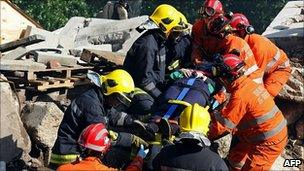Q&A: UK's small-scale earthquakes
- Published

Emergency drills that practise the response to earthquakes take place regularly in the UK
The UK, like the rest of northern Europe, is relatively quiet seismically. The majority of earthquakes occur at the boundaries of the major tectonic plates, where there is most movement. In Europe, this is to be found in the south. Nonetheless, small tremors will sometimes be felt far from the plate boundaries, such as in Britain.
How big are British quakes?
The news media in the UK will often report quakes around a magnitude three of bigger. These are slight compared with the nine-plus magnitude quake that rocked Sumatra in 2004 and triggered the Boxing Day tsunami, or the magnitude 8.8 quake that struck Chile in February 2010.
The magnitude scales quoted by seismologists are not linear. Each step equates to a 30-fold increase in the release of energy - so magnitude nine is actually 800,000 times bigger than a magnitude five quake, for example.
Also, the numbers do not give any indication of the damage caused. This will depend on many things: the number and quality of buildings close by, the nature of the soils on which they are built, etc.
For this reason, people living on either side of the street can have very different experiences. When someone says: "But I felt nothing", it may be explained simply by the construction used on their house.
How often do such tremors occur in the UK?
There are 200-300 quakes in Britain every year. Most are so small that no-one notices them. Historical data suggests that earthquakes of about magnitude 3.5 are likely to occur in the UK around once every year.
The largest recorded earthquake experienced in the UK occurred in 1931 and measured 6.1. The epicentre was Dogger Bank in the North Sea, and so the quake had little impact on the mainland.
What causes the earthquakes in the UK?
The largest earthquakes in the world occur close to plate margins, areas of the Earth's upper layers that are being rammed together or pulled apart. Tremendous energy is released when these rocks break or grind past each other.
The UK lies well away from the world's tectonic hotspots, but these processes still play a role in the country's relatively small tremors.
Many of the quakes in the UK are clustered around an enormous block of rock known as the Midlands Microcraton. This is an ancient, Precambrian (older than 590 million years) feature that runs up through Birmingham towards the Potteries.
It is composed of harder rocks than those either side of it. Although the details are not well understood, it seems likely that, in response to tectonic pressures originating in the Atlantic (where the surface of the Earth is being pulled apart), those softer rocks on either side are disturbed.
There are a number of active faults that line the Midlands Microcraton, and many of the tremors experienced on the western side of the English Midlands, up to the Pennines, are a result of rocks jostling in this area.
Britain also feels the effects of earthquakes in the North Sea. Here, the crust is much thinner and it is also marked by large numbers of faults.
The earth beneath our feet is never completely static. The crust is constantly on the move. For example, much of the UK is still rebounding after the melting of the great mass of ice that covered the country thousands of years ago.
And even on a daily basis, the crust will move up and down by many millimetres as the tides roll around the island nation.
If they are so small, why do scientists in the UK bother studying them?
The . It is useful to know how strong the shaking is at different distances, measured in terms of the effects that people notice - rattling windows, falling ornaments and so on.
Knowing the distance at which strong effects might occur in an earthquake is important for safety planning. Engineers at nuclear power stations, for example, need to understand how their plant may be affected by tremors.
- Published16 September 2010